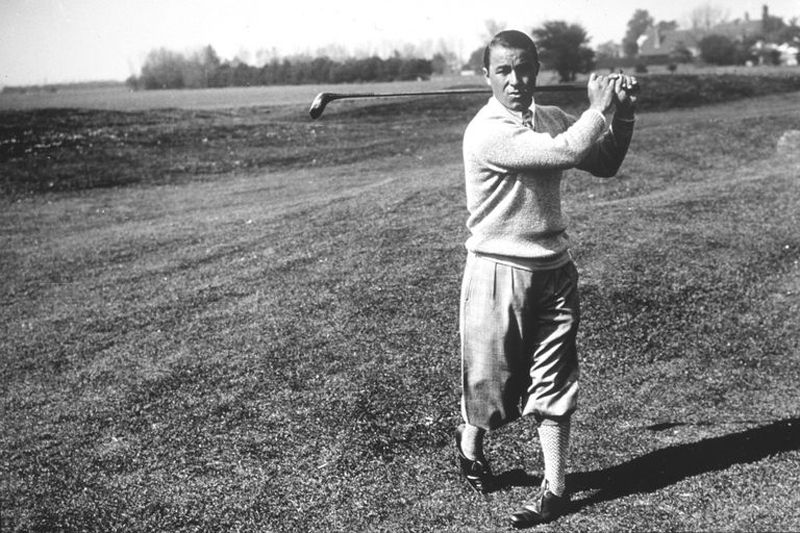Eugenio Saraceni was born to poor Italian immigrant parents on February 7, 1902 in Harrison, New York. Like many future hall of famers, he had to drop out of grade school to help support the family. His new job of caddie at the local golf course would change his life forever, and his sand wedge invention would improve your golf game each time you stepped into a bunker.
Sand wedges have been around since the Scots first started hitting a featherie ball (hand sewn leather pouch, stuffed with goose or chicken feathers) around a sheep pasture in the late 1700s, but today, thanks to Eugenio, the modern sand wedge is a multi-million-dollar industry. As the story goes, Eugenio was a close friend of billionaire Howard Hughes. One day in 1930, Hughes gave him an airplane ride in one of his collector planes. As the plane rose and descended, Eugenio noticed the flaps moving up and down to create wind resistance or lack of resistance. So he thought, why not add a large flange to a niblick (similar to a pitching wedge today) and hit behind the ball in a trap to lift the ball up and out toward the green. Eugenio sent the prototype to the Wilson Company and the modern sand wedge was born.
The Rest of the Story
Eugenio Saraceni later changed his name to Gene Sarazen. He loved the game of golf, and at age nine his parents gave him a used golf club for his birthday. Gene was determined to teach himself the game when he wasn’t working as a caddy.
At age thirteen, he shot his first round under 70, but his young career was put on hold when his father made him get a higher paying job in a carpenter shop. After two years of bad health from working indoors, a doctor recommended that he get a job outdoors. This turn of fortune landed him an assistant pro job back at the local golf course. And at age eighteen, he turned into a full-time professional golfer. Two years later, at the tender age of twenty, he won both the U.S. Open and the PGA Championship,
The next year he won the PGA Championship (again) and by 1927 he was playing on the first Ryder Cup team, which defeated the Europeans 9 ½ to 2 ½. In 1932, using his newly invented sand wedge, he won the British Open and the U.S. Open. When he won his third U.S. Open the next year, pro golfers as well as amateurs began using his new sand wedge.
Arguably, the greatest golf shot of his career came in his first appearance at the 1935 Masters Championship. Behind by three shots on the par five fifteenth fairway, he hit a four wood for his second shot, which travelled 235 yards and rolled into the hole for a double eagle. With that shot, he tied the tournament leader (Craig Wood) and beat him in a thirty-six hole playoff 144-149 to win his only Masters Championship.
Nicknamed “The Squire,” he became a golfing legend around the world and played competitively until 1973. (Sidebar: At age 71, Sarazen played in the 1973 British Open and hit a hole-in-one on the famed “postage stamp hole” at the Royal Troon Golf Course.)
Sarazen finished his career with thirty-nine PGA tour wins, including seven major tournaments. He was elected to the World Golf Hall of Fame in 1974 and died at age 97 in 1999 in Naples, Florida.
19th Hole Trivia
• In 1991, Ian Woosnam won the Masters to become the shortest winner ever. (Sarazen was 5 feet 5.5 inches, while Woosnam was 5 feet 4.5 inches)
• When Sarazen won the 1935 Masters Tournament, he became the first golfer to win the professional Grand Slam (The Masters, The U.S. Open, The British Open and The PGA Championship).
• In 1966, he was awarded the PGA’s first Lifetime Achievement Award.
• In 2000, Golf Digest ranked him the 11th greatest golfer of all time.
• Bobby Jones and Walter Hagen both witnessed his double eagle at the 1935 Masters Tournament.
• Wilson’s contract with Sarazen lasted 75 years.




















































